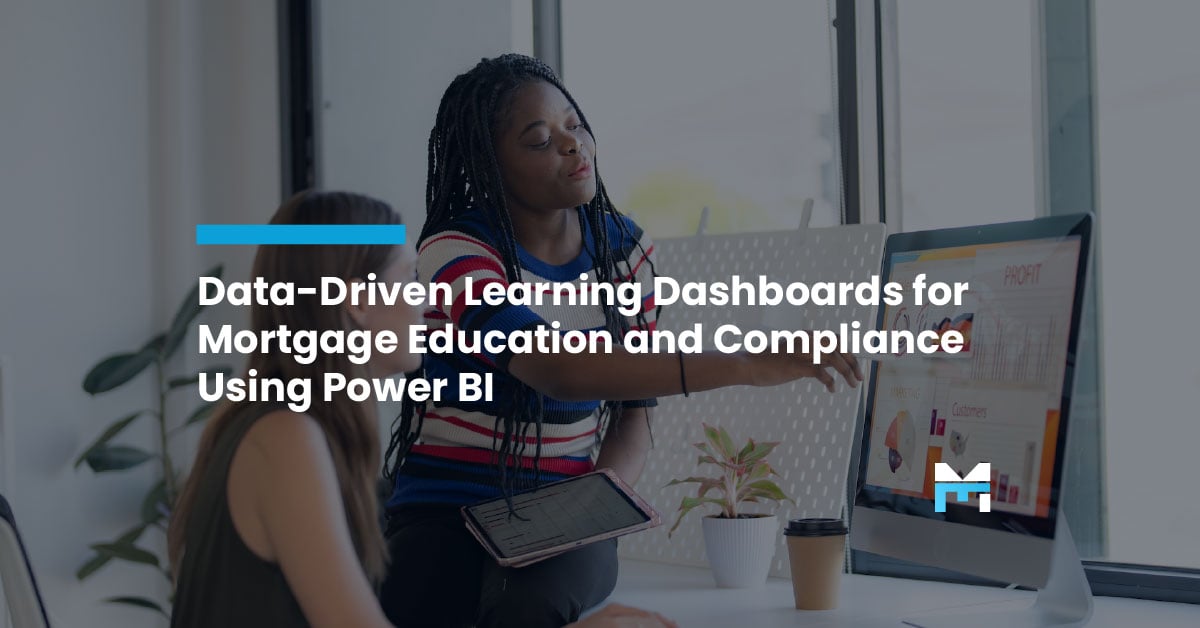Migration Myths Busted: What You Need to Know About Moving Mortgage Data Seamlessly
The prospect of migrating mortgage data can sound daunting. Risk, complexity, and time-consuming processes often come to mind, leading many...
Information Security Compliance
Add security and compliance to Microsoft 365
BI Reporting Dashboards
Realtime pipeline insights to grow and refine your learning operation
Integrations for Banks & Credit Unions
Connect LOS, core platforms, and servicing system
Productivity Applications
Deploy customized desktop layouts for maximum efficiency
Server Hosting in Microsoft Azure
Protect your client and company data with BankGrade Security
5 min read
Justin Kirsch : Aug 25, 2025 2:00:00 PM

You’d think by now, with all the tools we have, training data would speak for itself. But in too many mortgage companies, it still gets buried in static reports and spreadsheets.
Learning teams are often left guessing if their compliance programs are working or if anyone’s even paying attention. That’s a problem, especially in a field where getting it wrong has real consequences.
Data-driven learning dashboards built with Power BI are changing that. These dashboards do more than display progress; they make trends, gaps, and risks visible in real time. For compliance officers and L&D teams, it means fewer blind spots and better decisions.
In this blog, we’ll break down how Power BI dashboards can turn training data into actionable insights for mortgage education and compliance. Read on!
Table of Contents
|
Most mortgage firms still treat training as a one-time event, not an ongoing metric. However, the regulatory pressure, tech complexity, and cost of missteps have made passive compliance tracking dangerously outdated.
Here’s why that mindset no longer holds up:
A well-built learning dashboard provides deeper insights, tracking not just participation but also actual understanding, risk concentration, and organizational readiness.
Here’s how it helps:
It’s one thing to finish a course and another to retain the material. Dashboards let you map test performance against completion logs. For instance, if 100% of employees completed cybersecurity training but 40% failed the quiz twice, that’s a flag, not a win.
You can isolate which departments are lagging on mandatory topics like Fair Lending or AML. For example, if Loan Ops has 12 overdue licenses, the dashboard highlights this by team and date, making follow-ups targeted, not scattered.
Assign and monitor learning tracks based on job titles or departments. A processor doesn’t need the same content as an underwriter. With dashboards, training is relevant, and audit evidence is centralized; no scrambling during reviews.
Track re-engagement skipped modules, or repeated failures. If a branch finishes faster than average but performs worse, the dashboard tells you that. These are signals of how your team is behaving, not just what they’ve clicked.
Power BI stands out because it’s more than just a visualization tool; it’s a control center for compliance insights. For mortgage companies managing layered training programs, shifting regulations, and distributed teams, Power BI brings everything under one roof:
Already using Microsoft 365 in your mortgage firm? Power BI dashboards can work right out of the box. Talk to our team at Mortgage Workspace to see how your existing tools can power smarter compliance.
A good dashboard does more than display data; it organizes the right data for the right people. Whether you’re reporting to compliance leads or the executive team, here are the essentials to include from the start:
Even the most advanced dashboards lose their value if they’re built without a clear focus. It’s not just about adding more data; it’s about showing the right data, in the right way, for the right people.
Dumping every available data point into a single view clutters the experience and buries what matters. Compliance leads don’t need to see login times or device types; they need to identify red flags, such as overdue training, failed assessments, and risk exposure.
A dashboard built last quarter is already outdated if it’s not synced with live systems. Static reports force teams to make decisions based on stale information, which defeats the entire point of using a dynamic tool like Power BI.
Executives care about overall risk posture. L&D teams want training behavior. Compliance officers need audit trails. Showing the same dashboard to all three means none of them get what they need. Build with roles in mind, not a one-size-fits-all template.
Compliance often gets attention when something goes wrong: a missed deadline, a failed audit, or a regulatory fine. But it doesn’t have to work that way. A well-designed dashboard provides visibility before problems arise. You don’t wait for an issue; you catch it early.
With real-time insights, leaders can identify where teams are falling behind, which certifications are overdue, and where knowledge gaps pose a risk. It’s not just reporting; it’s foresight.
Need help setting up a secure and scalable learning dashboard for your mortgage compliance program? Talk to a Microsoft-certified data expert from Mortgage Workspace to get started!
Key Takeaways
|
Yes. Power BI integrates with the most popular Learning Management System (LMS) platforms, Microsoft 365 applications, and HR systems, enabling you to centralize training and compliance data without switching tools.
Dashboards should update in real time or, at a minimum, daily. Static or manually refreshed dashboards increase the risk of decisions based on outdated information.
Focus on training completion rates, assessment performance, overdue certifications, and department-level trends. These metrics help spot compliance risks early and drive corrective actions.

The prospect of migrating mortgage data can sound daunting. Risk, complexity, and time-consuming processes often come to mind, leading many...

Think of the last time you submitted or processed a mortgage application. How long did it take to pull together the applicant’s financial data? Days?...

When it comes to mortgage systems, precision and efficiency are everything. Yet one common challenge mortgage professionals face is ensuring seamless...